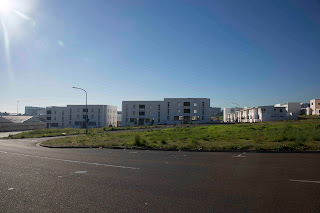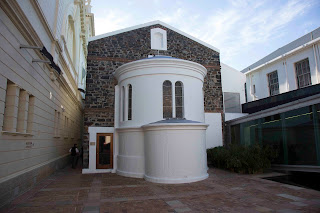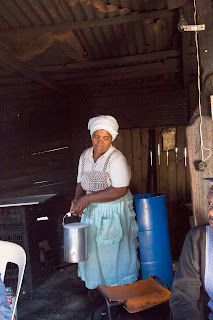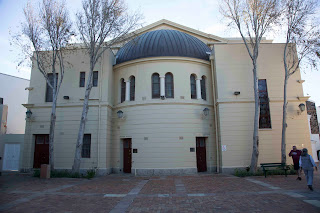We apparently have been extremely lucky with the weather. Clive told us that visitors can come for 3 or 4 days without ever seeing the top of Table Mountain. This morning was again gorgeous. Godfrey, Clive's associate, was our guide for the day on his home turf, the township, Langa. Townships are found in all areas in S. Africa and represent some of the lasting effects of apartheid. Langa is one of the smallest with a population of 250,000 with some larger townships, like Soweto in Johannesburg, having over 1 million. Before heading to Langa, we stopped in the area of District 6. Cape Town was divided into several districts, and District 6 happened to be a mix of Black, White, and Coloured (which included mixed racial, Indian, etc.) South Africans. They all lived together in harmony until apartheid. In the early 60's the government decided to bulldoze the entire district and to evict the whole population.
 |
| District 6 |


Next up was lunch in the township. After our pub experience we were pretty sure lunch was not going to happen. We were pleasantly surprised to find our restaurant in a more affluent (as opposed to the more effluent area we had just departed) section. The restaurant was owned by Sheila, a great hostess with a wonderful sense of humor. Lunch consisted of about 15 different items laid out buffet style which included several local vegetarian dishes as well as both a kudu and an ostrich dish. Everything was delicious, though my gi tract had taken a turn for the worse after breakfast. As it turns out, I had developed food poisoning which caused a bit of distress for the next 24 hours or so.
 |
| Sheila |
Our final stop in Langa was a house visit to one of the hostels (not anything like what we call a hostel). There are three levels of housing in the townships. The nicest are the "civil servant" houses, which are single family homes. The next level down is "informal housing", attached ramshackle houses with corrugated tin roofs. Bathrooms consist of port-o-potties, though since the end of apartheid, water and electricity run into most of these. Illegal electricity is a big problem leading to many rapidly spreading fires amongst the contiguous structures. Satellite dishes are also omnipresent. I guess everyone in the world has to watch "American Idol". These homes, though often dilapidated on the outside, are kept nicely furnished inside, a testament to their pride in ownership. The final type of living quarters is the most disturbing, the "hostels". These are owned by the government, and were originally designed as an apartment for Black male workers in Cape Town. The apartment consisted of 3 bedrooms, each for 2 men, a bathroom and shower, and a common area with a sink and large table. During apartheid, in order to accommodate the huge numbers of displaced families, 6 entire families often consisting of 8 or 9 people each were crammed into these apartments. Birth control is virtually non-existent leading to very large families. Extended families, including nieces and nephews , aunts and uncles can also be found sharing the space originally planned for a single male worker. At night, mattresses are placed on the floor. 20 years after apartheid ended, these families are still living in this manner. Lighting is poor from only a few bare bulbs, paint is peeling from the walls, and a tiny dorm refrigerator and hot plate are what pass as kitchen appliances. According to Godfrey, who was born in Langa and continues to live here, the sense of community is so strong, that people find it hard to leave. Godfrey tried living in the city for about 3 months and felt so isolated that he returned to Langa and is very happy here. Though he was born in informal housing, he now lives in the civil servant housing with his wife and son.
Because it was a Sunday and the schools were closed, we were unable to see inside a school. Education is compulsory to age 16, and schools are free, but if you want to send your child to the "good school," you need to pay for "supplies and fees". Godfrey is sending his son to day care now, and will send him to the private public school next year when he turns 6.
 |
| Hostels |
 |
| Informal Housing |
We left Langa somewhat subdued, and somewhat in shock, but with a much better understanding of the terrible effects that apartheid had on Black South Africans. What we cannot understand is why the present regime, many of the leaders of which came from the townships, have not done more to improve the standard of living other than to make unfulfilled promises.
By the time we left Langa it was getting pretty late, and it unfortunately left us with only an hour to visit the South African Jewish Museum. I was particularly interested in Jewish settlement in the late 1800's since my maternal great-grandfather came here briefly with his brother to seek their fortune in the diamond mines. They eventually emigrated to America and brought their families including my grandfather to NYC. If it were different, I may have had a funny accent also (Clive, if you're reading this, I'm just kidding).
After a whirlwind at the museum, I started to feel downright awful, so Godfrey dropped me at the hotel, then the rest of the crew rode up to Signal Hill adjacent to Table Mountain to watch the sunset.
 |
| South African Jewish Museum |
 |
| 1st Synagogue in Cape Town |
 |
| Bridge to Nowhere |


















Craig, rest up and see a Doc please, we are worried your blog will get boring if you don't! (-; feel better
ReplyDelete